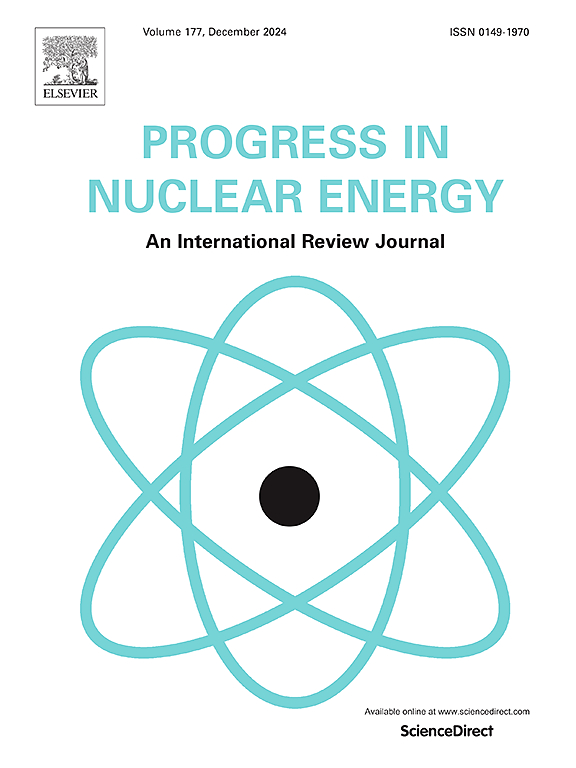开发钠池气溶胶洗涤半经验模型
IF 3.3
3区 工程技术
Q1 NUCLEAR SCIENCE & TECHNOLOGY
引用次数: 0
摘要
在钠冷却快堆中,燃料棒的故障可能导致放射性裂变产物释放到冷却剂池中。放射性核素可能通过气泡夹带被输送到盖气区,从而影响反应堆系统的正常运行。因此,钠池上升气泡中放射性裂变产物气溶胶的洗涤机理的计算对于保证快堆的安全运行至关重要。在这项研究中,我们打算提出一个新的钠池洗涤模型来评估钠池对裂变产物的保留能力。该模型包括两个模块:气泡动力学模块,用于计算气泡尺寸、偏心率和上升速度;气溶胶池洗涤模块考虑四种气溶胶去除机制:布朗扩散,重力沉降,惯性沉积和蒸汽冷凝。首先通过PLOF+和UTOP+两种瞬态场景对模型进行验证。此外,利用SRT(简化放射性核素输运)实验对模型进行了验证。为了进一步提高模型的精度,我们引入了一个相关因子来修正惯性沉积效应。此外,还讨论了各关键参数对洗涤池效率的影响。结果表明:较大的气泡直径和较深的气泡深度对池擦洗效率有促进作用;颗粒直径的影响是非单调的;池温无明显影响。本文章由计算机程序翻译,如有差异,请以英文原文为准。
Development of a semiempirical model for the aerosol scrubbing in a sodium pool
In sodium cooled fast reactors, failure of fuel rods may result in the release of radioactive fission products into the coolant pool. Radionuclides may be transported to the cover gas area through bubble entrainment, thereby affecting the normal operation of the reactor system. Therefore, the calculation of the scrubbing mechanism of radioactive fission product aerosols in the rising bubbles of the sodium pool is crucial to ensure the safe operation of fast reactor. In this study, we intend to propose a new sodium pool scrubbing model to evaluate the retention capacity of sodium pools for fission products. The model includes two modules: bubble dynamics module to calculate bubble size, eccentricity, and rising speed; aerosol pool scrubbing module considering four aerosol removal mechanisms: Brownian diffusion, gravitational sedimentation, inertial deposition, and vapor condensation. The model was firstly validated by two transient scenarios, PLOF+ and UTOP+. Moreover, SRT (Simplified Radionuclide Transport) experiments were utilized to validate the model. To further improve the accuracy of the model, we modified the model by introducing a correlation factor to correct the inertial deposition effect. In addition, the influence of various key parameters on the efficiency of pool scrubbing was discussed. The results show that larger bubble diameters and deeper depths have a promoting effect on the pool scrubbing efficiency; The influence of particle diameter is nonmonotonic; The pool temperature has no significant impact.
求助全文
通过发布文献求助,成功后即可免费获取论文全文。
去求助
来源期刊

Progress in Nuclear Energy
工程技术-核科学技术
CiteScore
5.30
自引率
14.80%
发文量
331
审稿时长
3.5 months
期刊介绍:
Progress in Nuclear Energy is an international review journal covering all aspects of nuclear science and engineering. In keeping with the maturity of nuclear power, articles on safety, siting and environmental problems are encouraged, as are those associated with economics and fuel management. However, basic physics and engineering will remain an important aspect of the editorial policy. Articles published are either of a review nature or present new material in more depth. They are aimed at researchers and technically-oriented managers working in the nuclear energy field.
Please note the following:
1) PNE seeks high quality research papers which are medium to long in length. Short research papers should be submitted to the journal Annals in Nuclear Energy.
2) PNE reserves the right to reject papers which are based solely on routine application of computer codes used to produce reactor designs or explain existing reactor phenomena. Such papers, although worthy, are best left as laboratory reports whereas Progress in Nuclear Energy seeks papers of originality, which are archival in nature, in the fields of mathematical and experimental nuclear technology, including fission, fusion (blanket physics, radiation damage), safety, materials aspects, economics, etc.
3) Review papers, which may occasionally be invited, are particularly sought by the journal in these fields.
 求助内容:
求助内容: 应助结果提醒方式:
应助结果提醒方式:


